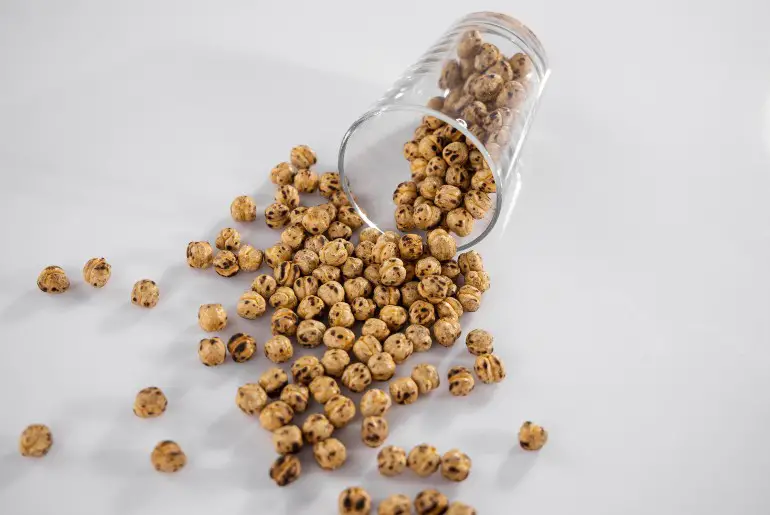You may have heard of aquafaba, but what exactly is it? Aquafaba is the syrupy cooking liquid from legumes (lentils, peas, beans, etc.) commonly used as a vegan egg substitute. Typically the liquid surrounding canned garbanzo beans (chickpeas) is used. This is because aquafaba from garbanzo beans supposedly foams the best and has a neutral flavor and color. However, you can use aquafaba from other beans such as great northern or black beans.
How Was Aquafaba Discovered?
The term aquafaba combines Latin words “aqua,” meaning water, and “faba,” meaning beans. So basically, it is a fancy term for bean water (usually chickpea water). Aquafaba was discovered in the search for a more versatile vegan egg replacer. There are commercial egg replacers, but they don’t have foaming properties. There are also several DIY egg replacers, such as bananas and flaxseed, which can work well in baked goods but also don’t foam. This has left vegan or egg-free individuals unable to eat certain foods such as lemon meringue pie, meringue cookies, and divinity.
In the search for a better egg replacement, aquafaba appeared. The generally accepted timeline is that around 2014, French tenor Joël Roessel did experiments with the molecular gastronomy of bean water. Building on those experiments, Goose Wohlt, a vegan software engineer from Indiana, created whipped chickpea brine with similar properties to egg white foam. This was then picked up by vegan blogs and eventually by the general media.
How Does Aquafaba Work?
Unfortunately, the exact science of how aquafaba works is not clear. Whipped egg whites have proteins that help trap air and create pockets of gas suspended in the egg’s liquid (check out this article for more info on egg white foams). Aquafaba contains starches and proteins that have leached from the legumes while cooking. It also contains saponins which are foaming agents found naturally in many plants.
The proteins in aquafaba likely contribute to aquafaba’s foaming abilities. The saponins also contribute. However, like egg white foams, aquafaba will foam better and have greater stability if whipped with cream of tartar and sugar.
How to Use Aquafaba
Aquafaba can be used for many purposes, including meringues, mayo, and marshmallow fluff, as well as in baking. One whole egg is equivalent to about 3 tablespoons of aquafaba. To substitute one egg white, use 2 tablespoons and to substitute one yolk, use 1 tablespoon.
To make a meringue from aquafaba, start by draining your chickpeas, using a bowl to catch the aquafaba. Then add 1/8th teaspoon of cream of tartar for every can worth of aquafaba. Use a hand mixer to beat for several minutes, then slowly add however much sugar your recipe calls for a tablespoon at a time, thoroughly mixing it in before adding another tablespoon. You should be able to get stiff peaks from your aquafaba meringue.

Can I make Homemade Aquafaba?
Absolutely! All you have to do is cook 1 ½ cups of dried (rinsed) chickpeas in 4 cups of water. Then drain the chickpeas over a bowl to catch your aquafaba. You should end up with ¾ to 1 cup of cooking liquid (aquafaba). If you have more than that, you will need to simmer it down to about 1 cup, and if you have less than that, you will need to dilute it with water.
Aquafaba can be stored in the refrigerator for up to one week. You can also keep it in the freezer. To freeze, pour your aquafaba into ice cube trays. Once frozen, remove from trays and place in an airtight container or zip-top freezer bag. Frozen aquafaba should be good for 3-4 months. Once ready to use, pull from the freezer and allow to thaw.
Is Aquafaba Healthy?
There have been some concerns raised around aquafaba. One major concern is the possibility that it contains BPA. BPA is a chemical that can have negative health impacts. For decades, BPA was used in can linings and widely present in canned goods. Per the Environmental Working Group (EWG), 95% of food cans don’t use BPA, though it is unclear how much better these alternatives are (check out this EWG article for more information on BPA use in canned goods). If you are concerned about BPA from aquafaba from canned beans, you can always make your own aquafaba at home.
The other concern frequently raised about aquafaba is the presence of saponins. The specific concern is that saponins can cause GI issues. However, the amount of saponins found in aquafaba is very small and unlikely to cause significant problems. However, if you already have GI issues such as irritable bowel syndrome, you may want to avoid aquafaba.
Please check my other food facts articles if you enjoyed this article, such as my article on Ruby Chocolate and Learning About Sourdough Bread. Happy baking!





